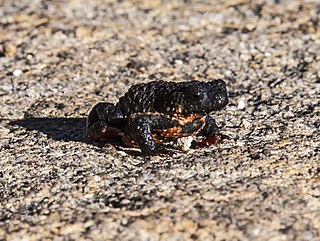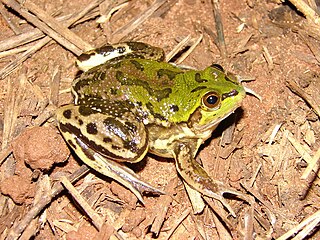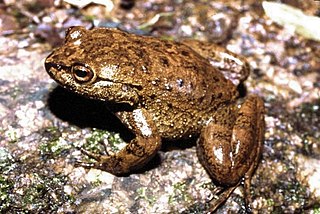
Melanophryniscus is a genus of toads in the family Bufonidae. They are found in northern half of Argentina, southern Bolivia, southern Brazil, Paraguay, and Uruguay. Common name South American redbelly toads has been coined for them.

Rhinella scitula is a species of toads in the family Bufonidae. It is found in the southwestern Mato Grosso do Sul, Brazil, and in the adjacent southeastern Paraguay.

Dendrophryniscus leucomystax is a species of toad in the family Bufonidae. It is endemic to southern and southeastern Brazil and occurs in coastal forests of Rio de Janeiro, São Paulo, and Santa Catarina states. It is a very common species living in secondary and primary forests on leaves near the ground and in bogs. Breeding takes place in rain pools on the ground. It is threatened by habitat loss caused by clear-cutting of forests and large-scale livestock farming.

The Maldonada redbelly toad is a species of toad in the family Bufonidae. It is endemic to Brazil. Its natural habitats are subtropical or tropical high-altitude grassland, swamps, and intermittent freshwater marshes.
Melanophryniscus spectabilis is a species of toads in the family Bufonidae. It is known from western Santa Catarina and southern Paraná states, southern Brazil. The specific name spectabilis refers to the showy color pattern of this species.
Siphonops hardyi, or Hardy's caecilian, is a species of caecilian in the family Siphonopidae. It is endemic to southeastern Brazil where it occurs in the states of São Paulo, Rio de Janeiro, Espírito Santo, and Minas Gerais, possibly wider. This species lives in soil and under leaf litter or stones in primary forest, plantations, and rural gardens. It is a common species; it can locally suffer from infrastructure development but is not generally threatened.
Dendropsophus rhea is a species of frog in the family Hylidae. It is endemic to Brazil. Its natural habitats are moist savanna, freshwater marshes, and intermittent freshwater marshes. It is threatened by habitat loss.
Boana buriti is a species of frog in the family Hylidae endemic to Brazil. Its natural habitats are moist savanna, subtropical or tropical moist shrubland, freshwater marshes, and intermittent freshwater marshes. It is threatened by habitat loss.
Boana stenocephala is a species of frog in the family Hylidae that is endemic to Brazil. Its natural habitats are moist savanna and rivers. It is threatened by habitat loss.

Pseudis bolbodactyla is a species of frog in the family Hylidae. It is endemic to southern Brazil and occurs in Minas Gerais, southern Goiás, southern Bahia, and northern Espírito Santo states. Although it is currently considered a valid species, it has also been treated as a subspecies of Pseudis paradoxa.
Pseudis fusca is a species of frog in the family Hylidae. It is endemic to Minas Gerais, Brazil, and only known few localities. Although it is currently considered a valid species, it has also been treated as a subspecies of Pseudis paradoxa.
Pseudis tocantins is a species of aquatic frog in the family Hylidae. It is endemic to central Brazil and occurs in the eponymous state of Tocantins, as well as in Goiás, Mato Grosso, and Maranhão states, in the Tocantins and Araguaia River basins.

Crossodactylus is a genus of frogs in the family Hylodidae. The genus occurs in Brazil, southern Paraguay, and northern Argentina. These frogs are sometimes known as Limnocharis, Tarsopterus, Calamobates, and by the common name spinythumb frogs. They typically inhabit streams in mountainous areas in the Atlantic Forest or in montane savanna.
Crossodactylus trachystomus is a species of frog in the family Hylodidae. It is endemic to the Espinhaço Mountains in Minas Gerais, Brazil.

Phantasmarana boticariana is a species of frog in the family Hylodidae. It is endemic to southeastern Brazil and only known from few specimens from its type locality, Parque Estadual do Itapetinga in Atibaia, São Paulo state.

Proceratophrys moratoi is a species of frog in the family Odontophrynidae. It is endemic to the São Paulo state, Brazil. Its local name is botucatu escuerzo.

Chiasmocleis crucis is a species of frog in the family Microhylidae. It is endemic to Bahia in eastern Brazil. It is known from Camamu, its type locality, and from the Serra Bonita Private Reserve of Natural Heritage in Camacan/Pau Brasil. The specific name crucis honors Carlos Alberto Gonçalves da Cruz, a Brazilian herpetologist.
Carlos Alberto Gonçalves da Cruz is a Brazilian herpetologist. He works at the National Museum in Rio de Janeiro.
Physalaemus insperatus is a species of frog in the family Leptodactylidae. It is endemic to southern Brazil and is only known from its type locality, Serra da Pedra Branca do Araraquara in Guaratuba, Paraná. The specific name insperatus means "unexpected" or "surprising" in Latin and alludes to the fortuitous finding of a new species among old museum specimens, originally identified as Physalaemus olfersii; taxonomically, it is part of the so-called Physalameus olfersii species group.
Dendrophryniscus skuki is a species of toad in the family Bufonidae. It is endemic to northeastern Brazil and only known from its type locality in the municipality of Itacaré, state of Bahia. This species is dedicated to herpetologist Gabriel "Gabo" Skuk, the species describer's friend who perished in a diving accident.










